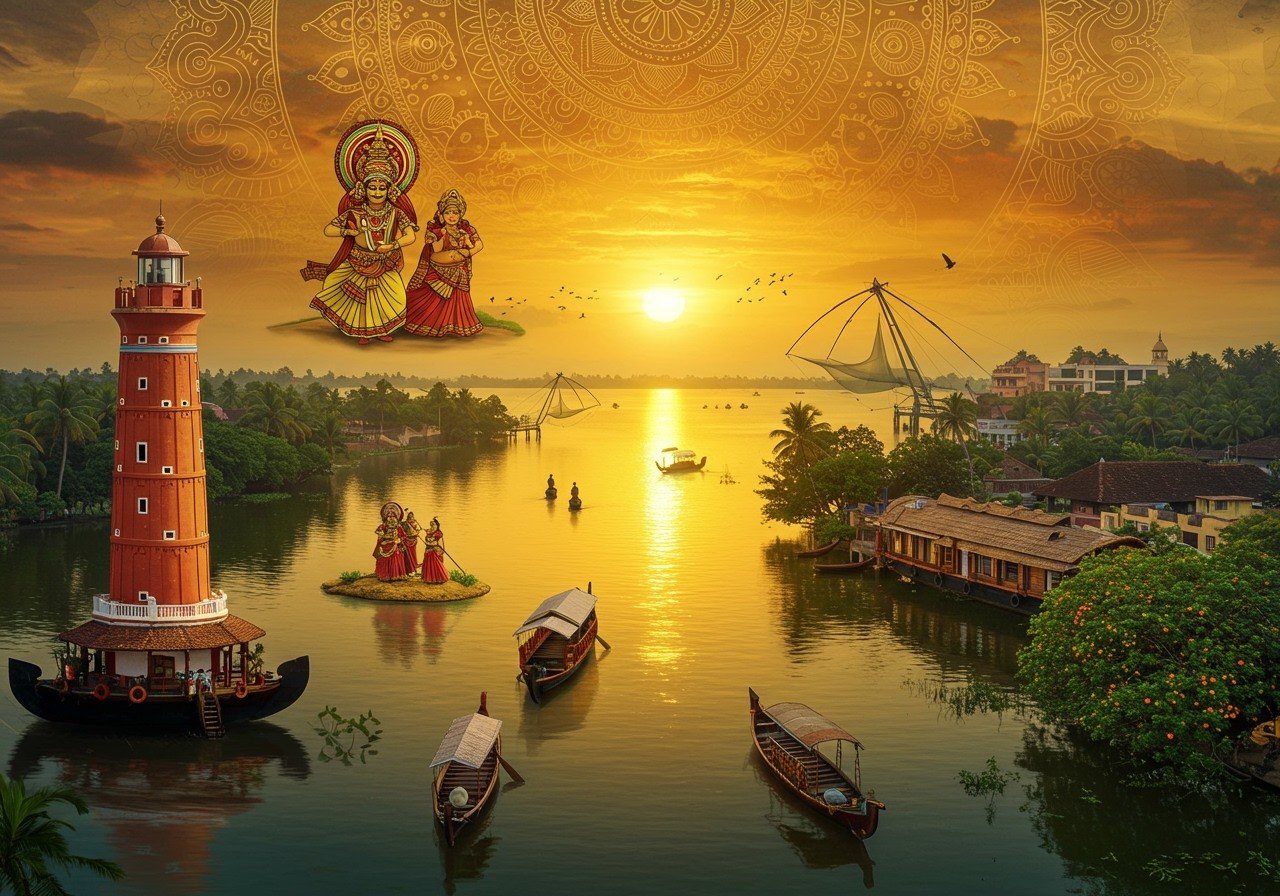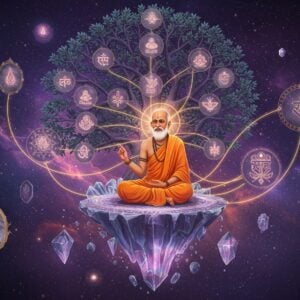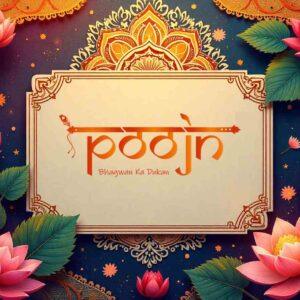
Embark on a captivating exploration of Kollam District, nestled in the southwestern gem of Kerala, India. Renowned for its rich tapestry of history, diverse geography, and vibrant cultural heritage, Kollam offers a unique blend of natural beauty and historical significance. Discover the captivating aspects that make Kollam a must-visit destination for culturally rooted travelers seeking an authentic Indian experience.
A Glimpse into Kollam’s Geography
Kollam’s strategic coastal location along the Laccadive Sea has historically established it as a bustling port city. The district’s varied landscape encompasses the lush Western Ghats, serene backwaters, and pristine beaches. Ashtamudi Lake, the second largest in Kerala, plays a vital role in the district’s ecological balance and economic prosperity. The Kollam Canal, an integral part of National Waterway 3, further enhances the region’s connectivity. Moreover, the unique flora and fauna of the Shendurney Wildlife Sanctuary establish it as a biodiversity hotspot within the district.
From navigating the expansive Ashtamudi Lake to venturing into the heart of the wildlife sanctuary, Kollam offers a plethora of experiences. Understanding the geographical features will enrich your journey through this historically rich region.
Delving into Kollam’s Historical Significance
Kollam, also known as Quilon, boasts the distinction of being one of the oldest seaports on the Malabar Coast. Its history dates back to the Roman era, signifying its prominent role in ancient trade routes. The spice trade, a significant economic driver, flourished here, attracting traders from distant lands like Europe, Arabia, and China. This vibrant commerce has indelibly shaped Kollam’s cultural and architectural landscape.
Influences from various dynasties, including the Chera, Chola, and Pandya, have left their mark on the district’s development. The Tangasseri Lighthouse, a towering sentinel, stands as a testament to the Portuguese, Dutch, and British colonial presence. It offers a poignant glimpse into a bygone era of maritime navigation. The annual Kollam Pooram festival, a grand celebration of culture and tradition, further underscores the district’s vibrant heritage.
Unveiling Kollam’s Cultural Heritage
Kollam is a beautiful tapestry woven with the threads of Hindu, Christian, and Muslim communities, each contributing its unique vibrancy to the district’s cultural fabric. Traditional art forms like Kathakali and Mohiniyattam, deeply embedded in Kerala’s identity, captivate audiences with their intricate expressions and evocative storytelling.
The district’s architectural marvels, including the Thangassery St. Thomas Fort and the Kottarakkara Ganapathy Temple, showcase the rich artistic heritage. Every structure whispers tales of devotion, artistry, and architectural brilliance. The district’s artisanal heritage shines through its traditional handicrafts, while its culinary scene tantalizes taste buds with fresh seafood and the authentic flavors of Kerala.
Kollam in the Contemporary Era
Kollam gracefully balances modernity with its historical charm. The district contributes significantly to Kerala’s economy, particularly through cashew processing and coir manufacturing, which provide livelihoods and showcase local expertise. Eco-tourism flourishes here, fueled by the picturesque landscapes and tranquil backwaters, while initiatives in sustainable development underscore the importance of preserving natural resources and cultural heritage. Kollam also prioritizes enhanced connectivity through its railway and road networks.
A Traveler’s Guide to Experiencing Kollam
Kollam welcomes travelers year-round with open arms. However, the most pleasant time to visit is during the Indian winters (November to February), creating ideal conditions for exploring Munroe Island and other attractions.
- Munroe Island: Experience the tranquility of the backwaters and immerse yourself in the local culture.
- Punalur: Marvel at the historical suspension bridge and the scenic beauty of the Kallada River. Enjoy the breathtaking landscapes that surround this historical landmark.
- Cultural Experiences: Witness captivating Kathakali performances or partake in the vibrant Kollam Pooram festival for a deeper understanding of local traditions. These experiences offer a window into the soul of Kerala’s artistic heritage.
Accommodation options range from luxurious resorts to traditional homestays, offering diverse experiences. Explore the district’s waterways with ease using houseboats and ferries. A visit to Kollam promises an enriching journey through time, culture, and nature.
Poojn.in: Your Companion for Temple Visits and Rituals in Kollam
As you explore the sacred temples of Kollam, Poojn.in stands ready to provide you with all the necessary puja items and ritual materials. Our online store offers a comprehensive selection to enhance your spiritual experience:
Essentials for Temple Visits:
- Complete Puja Thalis: Find traditional Kerala-style thalis, complete with all the essential items for your offerings. Carefully curated with authentic components, our thalis ensure a reverent experience.
- Offerings: Source pure coconuts and fresh flowers for temple offerings, ensuring the purity and freshness of your devotional gestures. Our offerings are sourced with utmost care and respect for tradition.
- Traditional Lamps and Wicks: Discover Kerala-style oil lamps and wicks to illuminate your prayers. Crafted with traditional techniques, our lamps add an element of authenticity to your rituals.
- Kumkum and Chandanam: Acquire authentic kumkum and chandanam for temple rituals, adding a touch of traditional sanctity. Sourced from trusted providers, our kumkum and chandanam uphold the purity of your rituals.
For Home Pujas:
- Brass Lamps (Nilavilakku): Illuminate your home shrine with exquisite Kerala-style brass lamps (Nilavilakku), available from ₹1,200. Their elegant craftsmanship elevates the ambiance of your puja space.
- Bell Metal Utensils: Find traditional bell metal utensils for your daily puja rituals. Crafted with precision and care, these utensils add a touch of tradition to your home.
- Cotton Wicks: Enhance your lamp lighting with pure cotton wicks, perfect for temple-style lamps. Their pure composition ensures a clean and steady flame.
- Panch Ratna Sets: Acquire Panch Ratna sets at a special price of ₹5 (regular price ₹10), enhancing the auspiciousness of your puja rituals. Don’t miss this limited-time offer to add these sacred elements to your collection.
Special Items for Kerala Temples:
- Sambrani (Dhoop): Infuse your space with the aromatic sanctity of authentic Kerala-style sambrani (dhoop). Its fragrant smoke creates a purifying atmosphere.
- Banana Leaves: Obtain traditional banana leaves, essential for offerings and serving prasad. Their natural elegance adds a touch of tradition to your rituals.
- Copper Kalash Sets: Enhance your puja with pure copper kalash sets, symbolizing abundance and prosperity. Their intricate designs add a touch of elegance to your sacred space.
- Puja Decorations: Adorn your puja space with Kerala-style decorations, creating a vibrant and auspicious atmosphere. Our selection includes a variety of traditional decorative items.
Easily order these items through:
- Website: www.poojn.in
- Phone: 03369029784
- WhatsApp: 9476142738
We ensure quality assurance and careful packaging for safe delivery across India. We take special care with fragile items to ensure they arrive in perfect condition.
Note: Prices are subject to change. Please visit our website for current rates.
Embracing the Essence of Kollam
As you conclude your exploration of Kollam District, you’ll carry a rich tapestry of experiences that seamlessly blend the old with the new. This journey through its vibrant history, diverse geography, and captivating culture is more than a mere trip – it’s a passage into the heart of Kerala. Kollam’s landscapes, stories, and traditions offer a warm embrace, welcoming you into a world where every corner whispers a tale.
The district’s allure resides in its remarkable ability to preserve its heritage while gracefully transitioning into the modern era. The traditional art forms, architectural wonders, and vibrant festivals invite you to become an integral part of its living culture. Kollam’s commitment to eco-tourism ensures the preservation of its natural beauty for generations to come.
Whether you’re meandering through ancient forts or gently gliding along tranquil backwaters, Kollam guarantees an experience that resonates deeply with your soul. It is a haven for those seeking authenticity, tradition, and the pure joy of discovery. As you depart, carry with you the enduring spirit of Kollam, a gentle reminder of the wonders that await when you embark on journeys that honor the past and embrace the future.
FAQs: Unveiling Kollam’s Geography, History, and Cultural Heritage
What is the geographical expanse of Kollam district? Kollam district spans approximately 2,491 square kilometers, showcasing a remarkable diversity of landscapes, from coastal stretches to undulating hilly terrains.
When did Kollam district come into being? Kollam district was officially formed on November 1, 1956, as part of the states’ reorganization in India. This marked a significant moment in the district’s administrative history.
What makes Kollam district renowned? Kollam district is celebrated for its thriving cashew industry, its substantial coir production, and the mesmerizing beauty of its backwaters. It also holds a distinguished position for its rich cultural heritage and historical significance.
Which are some of the must-visit tourist spots in Kollam district? Among the plethora of attractions, Ashtamudi Lake, Jatayu Earth’s Center, and the historic Thangassery Lighthouse stand out as prominent landmarks. The district also boasts numerous temples and pristine beaches.
How is the cultural legacy of Kollam district expressed? The cultural heritage of Kollam district is vividly reflected in its traditional festivals, captivating art forms like Kathakali, and ancient temples that resonate with history. Various cultural events and fairs further enrich the district’s cultural calendar.
What role does Kollam play in the historical narrative of Kerala? Kollam occupies a pivotal position in Kerala’s history, serving as a major trading port. Its involvement in the spice trade and interactions with international traders have shaped the region’s trajectory.
What distinguishes the geography of Kollam district? The geography of Kollam district is unique due to its remarkable blend of coastal areas, serene backwaters, and verdant hills. This diversity nurtures a variety of ecosystems and paints a stunning natural canvas.


